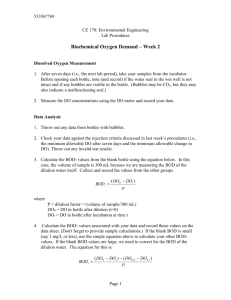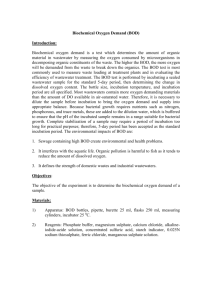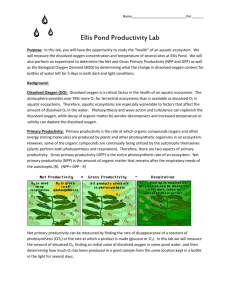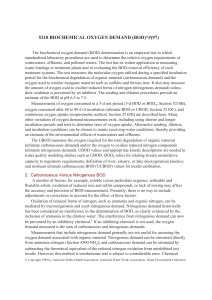CE 142L: Environmental Quality Laboratory
advertisement
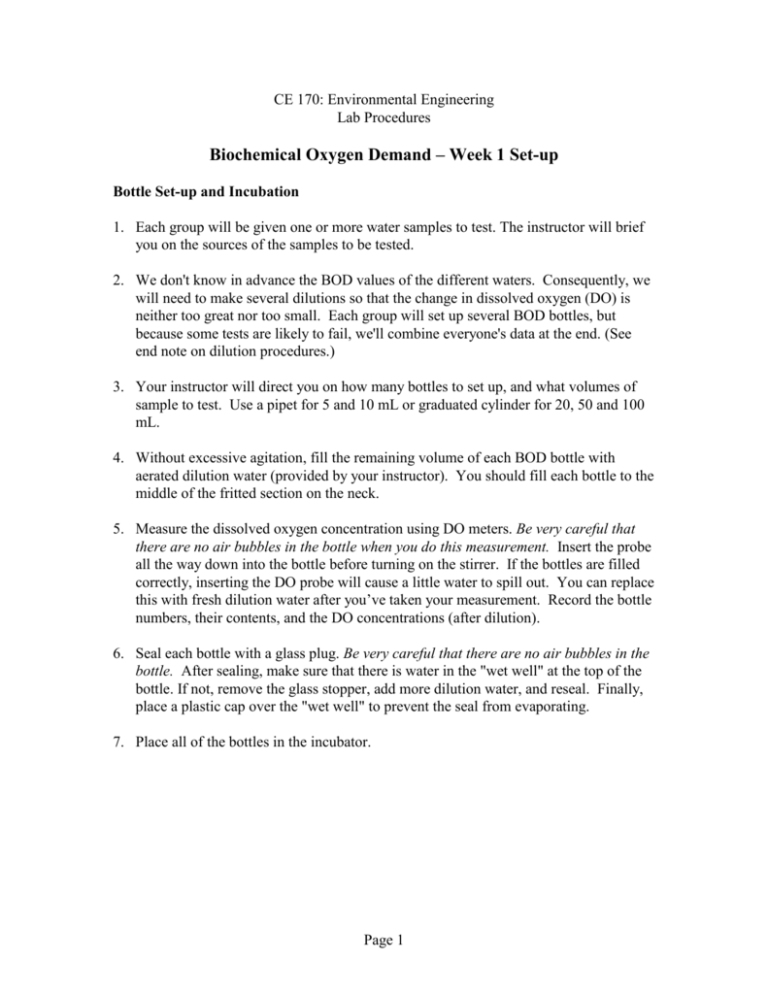
CE 170: Environmental Engineering Lab Procedures Biochemical Oxygen Demand – Week 1 Set-up Bottle Set-up and Incubation 1. Each group will be given one or more water samples to test. The instructor will brief you on the sources of the samples to be tested. 2. We don't know in advance the BOD values of the different waters. Consequently, we will need to make several dilutions so that the change in dissolved oxygen (DO) is neither too great nor too small. Each group will set up several BOD bottles, but because some tests are likely to fail, we'll combine everyone's data at the end. (See end note on dilution procedures.) 3. Your instructor will direct you on how many bottles to set up, and what volumes of sample to test. Use a pipet for 5 and 10 mL or graduated cylinder for 20, 50 and 100 mL. 4. Without excessive agitation, fill the remaining volume of each BOD bottle with aerated dilution water (provided by your instructor). You should fill each bottle to the middle of the fritted section on the neck. 5. Measure the dissolved oxygen concentration using DO meters. Be very careful that there are no air bubbles in the bottle when you do this measurement. Insert the probe all the way down into the bottle before turning on the stirrer. If the bottles are filled correctly, inserting the DO probe will cause a little water to spill out. You can replace this with fresh dilution water after you’ve taken your measurement. Record the bottle numbers, their contents, and the DO concentrations (after dilution). 6. Seal each bottle with a glass plug. Be very careful that there are no air bubbles in the bottle. After sealing, make sure that there is water in the "wet well" at the top of the bottle. If not, remove the glass stopper, add more dilution water, and reseal. Finally, place a plastic cap over the "wet well" to prevent the seal from evaporating. 7. Place all of the bottles in the incubator. Page 1 Dilution Procedures An important factor in the success of a BOD measurement is the size of the sample volume. If the sample volume is too large, the final dissolved oxygen concentration will be too low for a reliable assessment of BOD to be made. In other words, the bacterial action in the bottle will be limited by the availability of oxygen rather than the availability of food (biodegradable organics). On the other hand, if the sample volume is too small, the change in dissolved oxygen will be too small to give results that are statistically reliable. D.O. (mg/L) The effect of sample volume on the D.O. in the bottle during a BOD test is shown in the figure below. 8 7 6 5 4 3 2 1 0 0 1 2 3 4 5 tim e (d) Not enough sample Too much sample Effect of Sample Volume on Dissolved Oxygen During a BOD Test The standard criteria for deciding if a test is valid or not are listed below: Rejection Criteria Final DO < 1 mg/L DO0 - DOt < 2 mg/L Reason for rejection Sample volume too large Sample volume too small For any chosen dilution, you can calculate the range of BOD values that give valid tests. The upper BOD value can be calculated from assuming the starting D.O. to be a typical saturation value at room temperature (say, 8 mg/L) and setting the final D.O. equal to 1 mg/L. The lower BOD value can be calculated by setting the D.O. value to be 2 mg/L. A table of BOD ranges for different dilution factors is shown below: (Can you duplicate these calculations?) Page 2 BOD Measurable with Different Sample Dilutions (after Sawyer, et. al.) Volume of Sample in a 300-mL Bottle (mL) 0.02 0.05 0.1 0.2 0.5 1 2 5 10 20 50 100 300 Range of BOD Measurable (mg/L) 30,000 - 105,000 12,000 - 42,000 6,000 - 21,000 3,000 - 10,500 1200 - 4200 600 - 2100 300 - 1050 120 - 420 60 - 210 30 - 105 12 - 42 6 - 21 0-7 Based on past experience, we've chosen sample volumes for the various waters to be tested. To cover possible fluctuations from past experience, we will choose several dilutions to cover a wide range of possible BOD5 values. Some bottles will exceed the threshold values discussed above, but if we've chosen wisely, at least one bottle will result in a valid test. Page 3
